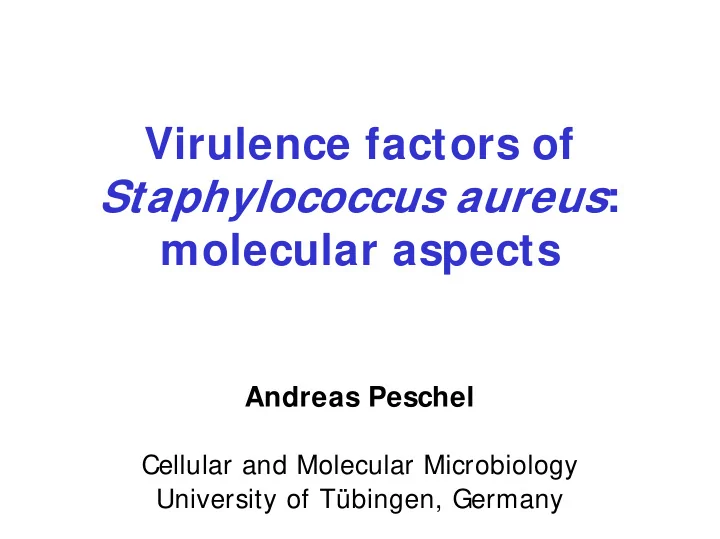

Virulence factors of Staphylococcus aureus : molecular aspects Andreas Peschel Cellular and Molecular Microbiology University of Tübingen, Germany
Mammalian skin - the staphylococcal ecosystem Risk factors for S. aureus infections: - Nasal colonization (30-40% of the population) - Use of catheters and artificial implants (Biofilm formation) - I mmunosuppression (Chemotherapy, CGD, cystic fibrosis, AIDS)
S. aureus infections S. aureus Infected implant • Skin and wound infections • Catheter and device-related infections • 40% of nosocomial infections • Sepsis , septic shock • More than 30.000 deaths per year (USA) • Multiple antibiotic resistance ( MRSA, VRSA ,...)
Host/ pathogen interaction 1. 3. 2. Antimicrobial I mmune Specific recognition peptides adherence
Covalent attachment of surface proteins Electrostatic Covalent Protein A, coagulase,… Autolysins Linkage motive -LPXTG- Murein Inner membrane T.J. Foster et al. Surface proteins with LPXTG motives: • Binding proteins for fibronectin, fibrinogen, collagen,... • Protein A (binding of IgG, van Willebrand factor, TNF α R • Clumping factor (coagulation)
Putative pathway of heme-iron acquisition Hemoglobin Heme-iron Fe Fe I sdA I sdB I sdC Fe Linkage motive -LPXTG- Fe I sdDEF ATP Fe Fe 2+ I sdG O. Schneewind et al. Homologs of isd genes in: Staphylococcus epidermidis Listeria monocytogenes Bacillus anthracis
The pro- and antichemotactic S. aureus system δ Toxin, CHIPS PSM peptides J. Van Strijp et al. M. Otto et al. � Leukocyte attraction: Release of nutrients I nhibition of chemotaxis: � Establishing infection
Conclusions: S. aureus is an extremely versatile human pathogen Many virulence factors are redundant Several virulance factors have opposing activities Complex regulation of virulence factors in response to environmental signals and bacterial density
Molecular basis of S. aureus nasal colonization Staphylococcus aureus Nasal epithelial cells Role of keratin-binding proteins (ClfB)? Role of teichoic acids?
> 20 putative WTA genes in S. aureus O tagO : tag cluster: dlt cluster: tagE cluster: tar cluster:
I nactivation of dltA in S. aureus dlt cluster: Mutant properties: - WTA and LTA are devoid of D-alanine - Susceptible to cationic antimicrobial peptides (Defensins, cathelicidins,…) Peschel, A., et al. (1999) J. Biol. Chem . 274 : 8405
Teichoic acid D-alanine confers resistance to antimicrobial defensin peptides Minimal inhibitory concentration of defensin hNP1-3: wild-type : > 60 S. aureus µM mutant ∆ dltA : 2.9 µM Susceptible Resistant Resistance mechanism: Introduction of positive charges into the cell wall Peschel, A. (2002) Trends Microbiol. 10, 179-186
Studying the role of WTA in nasal colonization? Purified WTA inhibits S. aureus adherence to nasal epithelial cells Aly R, Shinefield HR, Litz C, Maibach HI., J. Infect. Dis. 1980 141:463 WTA is essential for viability of Bacillus subtilis and Staphylococcus epidermidis Soldo B, Lazarevic V, Karamata D., Microbiology . 2002 148:2079 Fitzgerald SN, Foster TJ., J Bacteriol. 2000 182:1046 I s WTA perhaps not essential in S. aureus ? Chatterjee AN. J Bacteriol. 1969 98:519
Putative pathway of WTA biosynthesis 4. 3. 2. 1. 3. 4. Connection Modification with with hexoses and peptidoglycan D-alanin 1. 2. DltABCD Polymer Translocation synthese on Lipid-carrier TagO?
Growth kinetics: WTA is not essential in S. aureus ∆ tagO Compl. WTA-PAGE: ∆ tagO Wild- type O tagO : WTA
No impact of WTA deficiency on susceptibility to CAMPs Nasal antimicrobial peptides: 1. Wild-type � Normal WTA and LTA 2. ∆ tagO � No WTA 3. ∆ dltA � No D-Ala in WTA and LTA Weidenmaier, C, et al,. (2004) Nat. Med. 10, 243
WTA is required for nasal colonization Nasal colonization of Adherence to human nasal cotton rats epithelial cells John Kokai-Kun et al., Gaithersburg Wild-type: 15/ 15 Adherence (% ) ∆ tagO: 0/ 15 (no WTA) ∆ dltA: 4/ 15 (no D-ala) Weidenmaier, C, et al,. (2004) Nat. Med. 10, 243
WTA mediates specific attachment to human airway cells Preincubation of A549 with Binding of WTA-coated WTA preparations latex beads to A549 ∆ tagO ∆ dltA Wild-type � Normal WTA � No WTA � No D-Ala in and LTA WTA and LTA
WTA does not affect S. aureus binding to immobilized fibronectin Adherence to fibronectin- coated microtiter plates Similar results for other matrix proteins and keratin
WTA mediates specific attachment in cotton rat noses John Kokai-Kun et al., Gaithersburg Kinetics of nasal Preinstillation of WTA colonization into cotton rat noses Bacteria in the nose (% ) Days after instillation No preinstillation Wild-type Preinstillation with WTA ∆ tagO
S. aureus interaction with the endothelium Staphylococcus aureus Role of fibronectin- binding proteins (FnbPs?) Role of teichoic acids?
WTA structure is very variable Staphylococcus aureus: Backbone: Modification: Ribitol-P D-Ala , GlcNAc Staphylococcus aureus Glycerol-P D-Ala, GalNAc Staphylococcus aureus Type IV Glycerol-P D-Ala , GlcNAc, Glc Staphylococcus epidermidis GlcNAc-P D-Ala , ? Staphylococcus auricularis Staphylococcus saprophyticus Rto-P & Gro-P D-Ala, GlcNAc Ribitol-P D-Ala , GlcNAc/ Gal/ Glc Listeria monocytogenes Glycerol-P D-Ala , Glc Bacillus subtilis
Conclusions: WTA is not essential in S. aureus WTA is required for nasal colonization and adherence to nasal epithelial cells I nvolvement of WTA in host/ skin tropism? WTA is crucial for interaction with endothelial cells
Cellular and Molecular Microbiology, Tübingen: Iris Fedtke Gabi Hornig Daniel Schäfer Christopher Weidenmaier Petra Staubitz Rafik Oueslati Andreas Peschel Dirk Kraus Emir Kulaucovic Manuela Dürr Sascha Kristian Collaboration: F. Götz et al. (Tübingen) J. Kokai-Kun et al. (Biosynexus) M. Otto et al. (NIH, Hamilton) • DFG J. van Strijp et al. (Utrecht) • BMBF R. Landmann et al. (Basel) • EU A. Bayer et al. (Los Angeles) • Baden-Württemberg Research Fonds V. Collins et al. (Göteborg) • Biosynexus Inc. I. Autenrieth et al. (Tübingen)
Recommend
More recommend